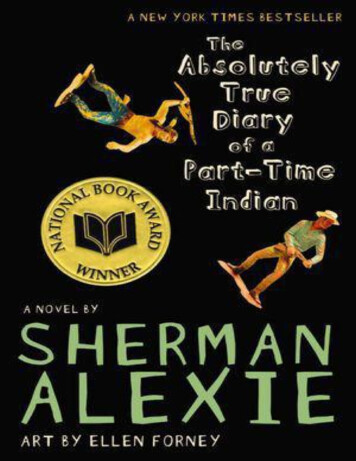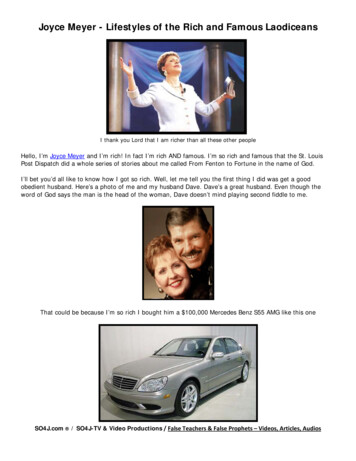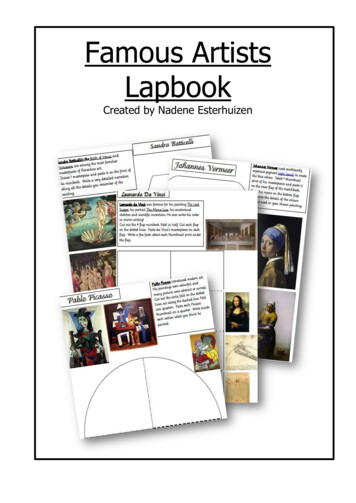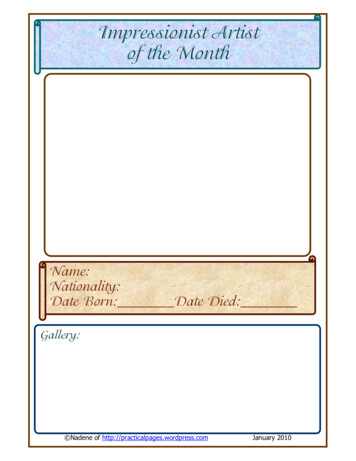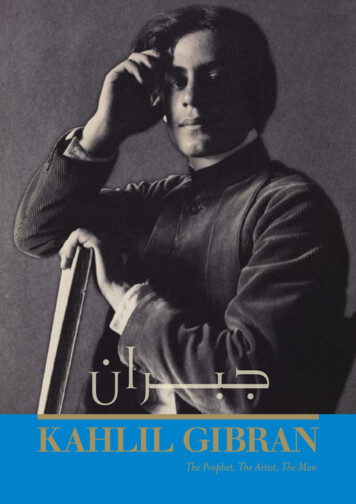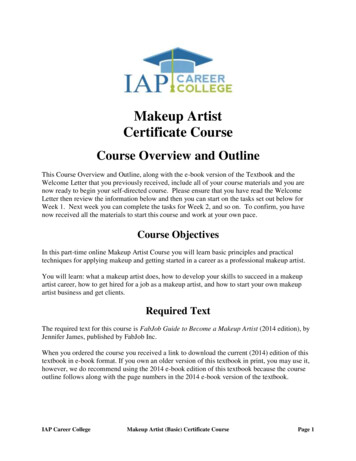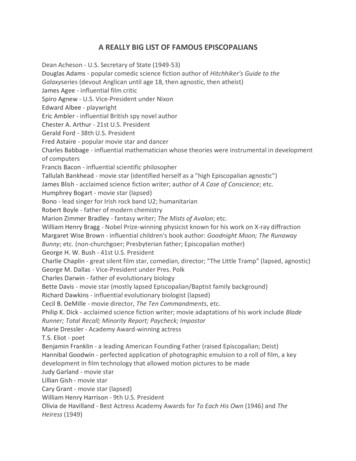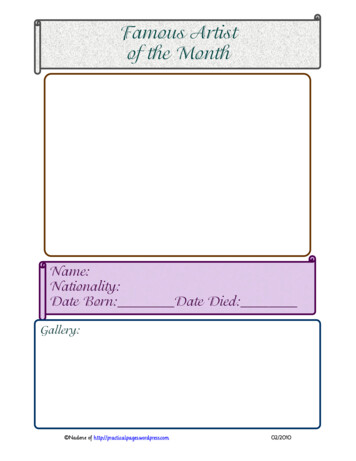
Transcription
-1-Famous Artistof the MonthName:Nationality:Date Born: Date Died:Gallery: Nadene of http://practicalpages.wordpress.com02/2010
-2-Famous ArtistsArtists1.Leonardo da Vinci2.Michelangelo di Lodovico3.Raffael Sanzio da Urbino4.Sandro Botticelli5.A van Dyck6.Rembrandt van Rijn7.Johannes Vermeer8.Francisco Goya9.Pablo Picasso10. Auguste Rodin11. Peter Paul Rubens12. Salvador DalDali13. Henry Moore14. Paul Jackson Pollock Nadene of http://practicalpages.wordpress.com02/2010
-3-Leonardo da VinciGallery:Leonardo da VinciThe Last SupperMona LisaVitruvian ManThe Virgin and ChildLeonardo di ser Piero da Vinci(April 15, 1452 – May 2, 1519), was an Italian polymath: painter, sculptor,architect, musician, scientist, mathematician, engineer, inventor, anatomist,geologist, botanist and writer. Leonardo has often been described as the archetypeof the Renaissance man, a man whose unquenchable curiosity was equaled onlyby his powers of invention.[1] He is widely considered to be one of the greatestpainters of all time and perhaps the most diversely talented person ever to havelived.http://en.wikipedia.org/wiki/Leonardo da Vinci Nadene of http://practicalpages.wordpress.com02/2010
-4-Michelangelo di LodovicoGallery:MichelangeloMichelangeloStatue of DavidPietà,Saint BartholomewSistine ChapelMichelangelo di Lodovic6 March 1475 – 18 February 1564, was an Italian Renaissance painter, sculptor,architect, poet, and engineer. Two of his best-known works, the Pietà and David,were sculpted before he turned thirty. Michelangelo also created two of the mostinfluential works in fresco in the history of Western art: the scenes from Genesison the ceiling and The Last Judgment on the altar wall of the Sistine Chapel inRome. As an architect, Michelangelo pioneered the Mannerist style at theLaurentian Library. At 74 he succeeded Antonio da Sangallo the Younger as thearchitect of Saint Peter's o Nadene of http://practicalpages.wordpress.com02/2010
-5-Raffael Sanzio da UrbinoGallery:RaffaelSybylSistine MadonnaWedding of the Virgin Madonna of MeadowRaffaello Sanzio da Urbino April 6 or March 28, 1483 – April 6, 1520better known simply as Raphael,Raphael was an Italian painter and architect of theHigh Renaissance, celebrated for the perfection and grace of his paintings anddrawings. Together with Michelangelo and Leonardo da Vinci, he forms thetraditional trinity of great masters of that period. Many of his works are foundin the Apostolic Palace of The Vatican. Nadene of edia.org/wiki/Raphael02/2010
-6-Sandro BotticelliGallery: PrimaveraSandro BotticelliVenus and MarsSandro Botticelli or Il BotticelloThe Birth of Venus(1445 – May 17, 1510) was an Italianpainter of the Florentine school during the Early Renaissance. He was born in thecity of Florence. He became an apprentice when he was about fourteen years oldand in 1462 he was apprenticed to Fra Filippo Lippi. By 1470 Botticelli had hisown workshop. Botticelli never wed. His paintings remained in the churches andvillas for which they had been created. His work has been seen to represent thelinear grace of Early Renaissance painting, and The Birth of Venus andPrimavera rank now among the most familiar masterpieces of Florentine art.http://en.wikipedia.org/wiki/Botticelli Nadene of http://practicalpages.wordpress.com02/2010
-7-Anthony van DykGallery:AnthonyAnthony van Dyk Painting of Courtiers, 1638 Henrietta Maria, 1688Triple Portrait of Charles 1;Sir Anthony van Dyck (22 March 1599 – 9 December 1641) was a FlemishBaroque artist who became the leading court painter in England. He is mostfamous for his portraits of King Charles I of England and Scotland and hisfamily and court, painted with a relaxed elegance that was to be the dominantinfluence on English portrait-painting for the next 150 years. He also paintedbiblical and mythological subjects, displayed outstanding facility as adraftsman, and was an important innovator in watercolour and etching.http://en.wikipedia.org/wiki/Anthony van Dyck Nadene of http://practicalpages.wordpress.com02/2010
-8-Rembrandt van RijnGallery:Rembrandt van RijnBelshassar’s Feast, 1636Anatomy Lesson of Dr. Tulp, 1632 Archangel leavesRembrandt van Rijn (July 15, 1606 – October 4, 1669) was a Dutch painter andetcher. He is generally considered one of the greatest painters and printmakers inEuropean art history and the most important in Dutch history.[1] His contributions toart came in a period that historians call the Dutch Golden Age. His reputation as anartist remained high, and for twenty years he taught nearly every important Dutchpainter. Rembrandt's greatest creative triumphs are portraits of his contemporaries,self-portraits and illustrations of scenes from the Bible.http://en.wikipedia.org/wiki/Rembrandt van Rijn Nadene of http://practicalpages.wordpress.com02/2010
-9-Johannes VermeerGallery:Johannes VermeerGirls with wine glass, 1659Music Lesson, 1662Girls with pearl earring, 1665Johan Vermeer (31 October 1632 -16 December 1675) was a Dutch Baroque painterwho specialized in exquisite, domestic interior scenes of middle class life. Vermeerworked slowly and with great care, using bright colours, sometimes expensivepigments, with a preference for cornflower blue and yellow. He is particularlyrenowned for his masterly treatment and use of light in his work. Vermeer' isnow acknowledged as one of the greatest painters of the Dutch Golden Age.http://en.wikipedia.org/wiki/Johannes Vermeer Nadene of http://practicalpages.wordpress.com02/2010
- 10 -Francisco GoyaGallery: Francisco GoyaFrancisco José de Goya y Lucientes (30 March 1746 – 16 April 1828) was aSpanish painter and printmaker regarded both as the last of the Old Mastersand as the first of the moderns. Goya was a court painter to the Spanish Crownand a chronicler of history. In 1786, Goya was appointed painter to Charles III,and in 1789 was made court painter to Charles IV. His portraits are notable fortheir disinclination to flatter. After contracting cholera and a high fever in 1792,Goya was left deaf, and he became withdrawn and co Goya Nadene of http://practicalpages.wordpress.com02/2010
- 11 -Pablo PicassoGallery: Pablo PicassoDora Maar au Chat, 1941 Boy with Pipe 1905 Three Musicians, 1921Sculpture ChicagoPablo Picasso (25 October 1881 – 8 April 1973) was a Spanish painter,draughtsman, and sculptor. He is one of the most recognized figures in 20thcentury art. He is best known for co-founding the Cubist movement and for thewide variety of styles embodied in his work. Picasso experimented with differenttheories, techniques, and ideas. Picasso’s creativity manifested itself in numerousmediums, including painting, sculpture, drawing, and architecture. He madeimmense fortunes throughout his life, making him the best-known figure intwentieth century art.http://en.wikipedia.org/wiki/Pablo Picasso Nadene of http://practicalpages.wordpress.com02/2010
- 12 -Auguste RodinGallery: Auguste RodinThe Thinker, 1879The Age of Bronze –PlasterThe Burghers of Calais, 1884Auguste Rodin (12 November 1840 – 17 November 1917) was a French sculptor. Heis generally considered the progenitor of modern sculpture. He was schooledtraditionally, and took a craftsman-like approach to his work, and desiredacademic recognition although he was never accepted into Paris's foremost schoolof art. Many of Rodin's most notable sculptures were roundly criticized duringhis lifetime. But Rodin's reputation grew, such that he became the preeminentFrench sculptor of his time Rodin remains one of the few sculptors widely knownoutside the visual arts community. http://en.wikipedia.org/wiki/Auguste Rodin Nadene of http://practicalpages.wordpress.com02/2010
- 13 -Peter Paul RubensGallery: Peter Paul RubensInfanta Isabella Clara Eugenia, 1566 Duke of Lerma, 1603Hippopotamus Hunt, 1616Raising the Cross, 1610Sir Peter Paul Rubens (June 28, 1577 – May 30, 1640) was a prolific seventeenthcentury Flemish Baroque painter, and used extravagant Baroque style thatemphasized movement, color, and sensuality. He is well-known for his CounterReformation altarpieces, portraits, landscapes, and history paintings ofmythological and allegorical subjects. His commissioned works were mostlyreligious subjects, "history" paintings, which included mythological subjects, andhunt scenes. His fondness of painting full-figured women gave rise to the terms'Rubensian' or 'Rubenesque' for plus-sized women.http://en.wikipedia.org/wiki/Peter Paul Rubens Nadene of http://practicalpages.wordpress.com02/2010
- 14 -Salvador DaliGallery:Gallery: Salvador DaliThe Persistence of MemorySculpture of The Persistence of Memory Discovery of America Christopher ColumbusSalvador Dalí i Domènech (May 11, 1904 – January 23, 1989) was a prominentSpanish Catalan surrealist painter born in Figueres. Dalí was a skilleddraftsman, best known for the striking and bizarre images in his surrealist work.His painterly skills are often attributed to the influence of Renaissance masters.His best-known work, The Persistence of Memory, was completed in 1931. Dalí'sexpansive artistic repertoire includes film, sculpture, and photography, incollaboration with a range of artists in a variety of media. Dalí was vador Dal%C3%AD Nadene of http://practicalpages.wordpress.com02/2010
- 15 -Henry MooreGallery: Henry MooreChac Mool stone statueFamily Group, 1950Reclining Figure, 1951Henry Spencer Moore (30 July 1898 – 31 August 1986) was an English sculptorand artist. He was best known for his abstract monumental bronze sculptureswhich are located around the world as public works of art. His forms are usuallyabstractions of the human figure, typically depicting mother-and-child orreclining figures. He fulfilled large-scale commissions which made himexceptionally wealthy. Yet he lived frugally and most of the money he earnedwent towards endowing the Henry Moore Foundation.http://en.wikipedia.org/wiki/Henry Moore Nadene of http://practicalpages.wordpress.com02/2010
- 16 -Paul Jackson PollockGallery: Paul Jackson PollockNo 5,. 194Number 1, 1950Full Fathom, 1947Green Silver, 1949Paul Jackson Pollock (January 28, 1912 – August 11, 1956) was an influentialAmerican painter and a major figure in the abstract expressionist movement.During his lifetime, Pollock enjoyed considerable fame and notoriety. He beganpainting with his canvases laid out on the studio floor, and he developed whatwas later called his "drip" technique. He used hardened brushes, sticks, and evenbasting syringes as paint applicators. Pollock's technique of pouring and drippingpaint is thought to be one of the origins of the term action painting.He died at the age of 44 in an alcohol-related, single-car crash.http://en.wikipedia.org/wiki/Jackson Pollock Nadene of http://practicalpages.wordpress.com02/2010
- 17 -OtherOther Web mSuggestions:oLaminate all the portraits and gallery pictures. (These could be re-usedeach few years.)oFor review, play a matching game and match the gallery to the correctartist.oLet your children research and find 3 more art works to add to thegallery.oExpand each biography and let your children give 5 – 8 facts about theartist studied.oLet your children study at least one art work in-depth. Let them narrateas many details as they can after some time studying the picture.oMake a sketch or reproduce their own version of their favourite art workfor each artist. Use other techniques – mosaic instead of pointillism, usewater-colour pencils and then ‘paint’ with water to give the paint effect forexample.oTry different art mediums through the year sculpture, splatter paints,water colours, pen & ink, charcoal, make prints, collages, oil paint/ acrylicpaints, photographs etc. oTry find additional coffee table books, library books, calendars or posterswith Art from as many eras as you have studiedoMake an Artist Time Line.oEnjoy art!I acknowledge that this is not a comprehensive list, but theselection covers several centuries and demonstrates the variety ofartists and their styles. Nadene of http://practicalpages.wordpress.com02/2010
Spanish painter and printmaker regarded both as the last of the Old Masters and as the first of the moderns. Goya was a court painter to the Spanish Crown and a chronicler of history. In 1786, Goya was appointed painter to Charles III, and in 1789 was made court painter to Charles IV. His p
